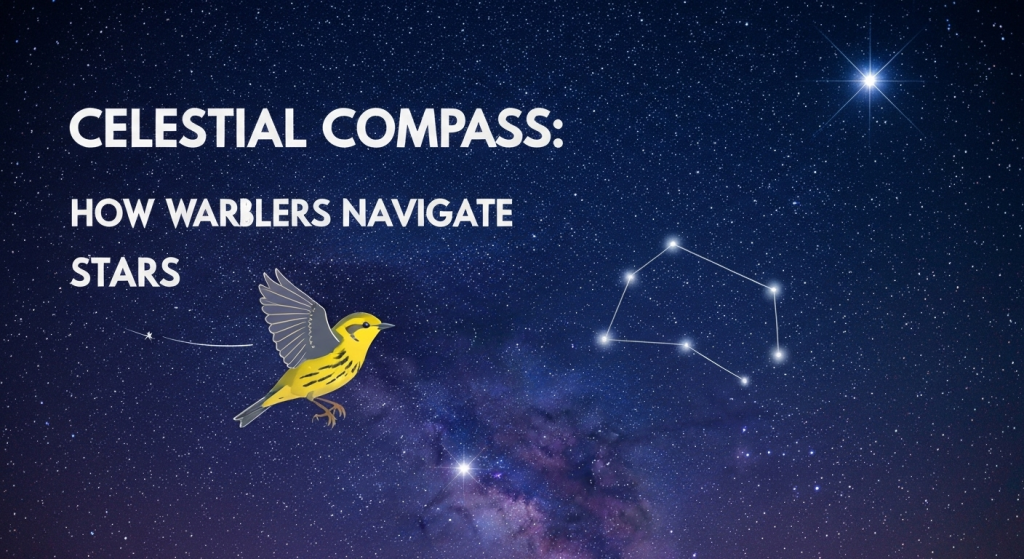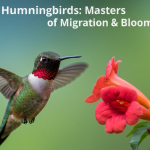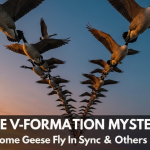Have you ever looked up at the night sky and felt a sense of wonder? It’s a vast, beautiful map of celestial bodies. For us, it’s a source of inspiration and history. But for a tiny warbler weighing less than a dollar coin, that same starry sky is a critical navigation tool. The fact that these small birds can undertake epic journeys of thousands of miles, flying through the dark of night, is one of nature’s most incredible feats. They don’t have GPS or a magnetic compass in their pocket. Instead, they possess an innate ability to read the stars, a skill honed over millennia of evolution. This article breaks down exactly how these feathered astronomers use the cosmos to guide their migration, from the clever experiments that revealed their secrets to the backup systems they use when the stars are hidden.
My name is Mahnoor Farooq, and for years, I’ve been captivated by the world of birds. My work has involved countless hours in the field, observing their behaviors, and just as many hours diving into the scientific research that explains them. What fascinates me most isn’t just identifying a species, but understanding the complex strategies they use to survive and thrive. The celestial navigation of warblers is a perfect example—it’s a beautiful intersection of biology, physics, and astronomy. My goal is to share this passion, translating the dense science into something everyone can understand and appreciate. It’s one thing to read about it, but another to truly grasp the genius behind a tiny bird charting its course by the stars.
The Dawn of Discovery: Unlocking the Secrets with the Emlen Funnel
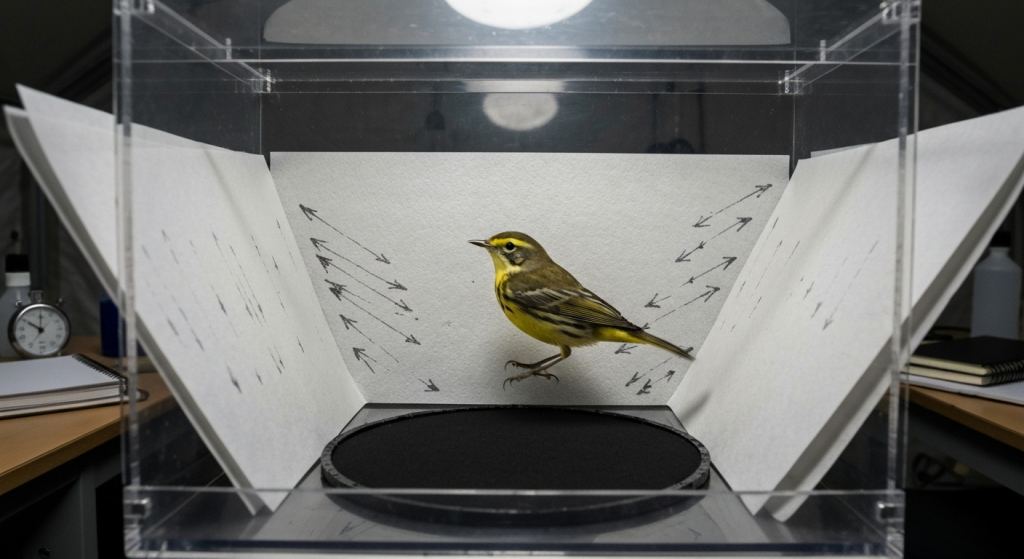
For a long time, scientists knew that birds migrated at night, but how they knew where to go was a complete mystery. The breakthrough came from a brilliantly simple yet effective invention: the Emlen funnel. Developed by Stephen T. Emlen in the 1960s, this device gave researchers their first real glimpse into the mind of a migrating bird.
Here’s how it works. The setup is a circular cage with a floor made of an ink pad. The walls of the cage are lined with blotting paper, forming a funnel shape. The top is covered with a screen, allowing the bird inside to see the night sky but preventing it from escaping. During migration season, birds feel a powerful, instinctual urge to fly in a specific direction. This urge is called migratory restlessness or zugunruhe. When a bird is placed in the Emlen funnel, it can’t fly, so it hops. It hops in the direction it wants to fly. As it hops, its feet get inky from the pad and leave marks on the sloped paper walls. By analyzing the pattern of these ink marks, scientists can clearly see the bird’s intended direction of travel.
I remember seeing diagrams of these funnel experiments during my studies, and the simplicity was striking. It’s a low-tech solution to a high-tech problem. The results were undeniable. Birds placed under a clear night sky consistently left ink marks pointing in their correct migratory direction. The Emlen funnel proved that the birds were getting their directional cues from the sky above.
Taking the Sky Indoors: Planetarium Experiments
The Emlen funnel was the key, but the lock was the sky itself, with all its variables. To truly understand what the birds were looking at, scientists needed to control the sky. The solution? They brought the birds inside and placed the Emlen funnels inside a planetarium. This was a game-changer. In a planetarium, researchers could manipulate the stars at will and observe how the birds reacted.
These experiments led to some amazing discoveries:
- Shifting the North Star: When scientists projected a normal sky, the birds oriented correctly. But when they shifted the position of Polaris (the North Star), the birds adjusted their orientation to match the new “north.”
- Removing Key Stars: Researchers could turn off specific stars or constellations. They found that removing a single star, even Polaris, didn’t confuse the birds much. This suggested they weren’t relying on one single point of light.
- Reversing the Sky: When the sky’s projection was rotated 180 degrees, the birds also reversed their direction, confirming they were reading patterns.
These planetarium studies proved, without a doubt, that warblers possess a “star compass.” They weren’t just vaguely flying toward a bright light; they were interpreting the geometric patterns of the stars to find their way.
Reading the Celestial Map: It’s All About Rotation
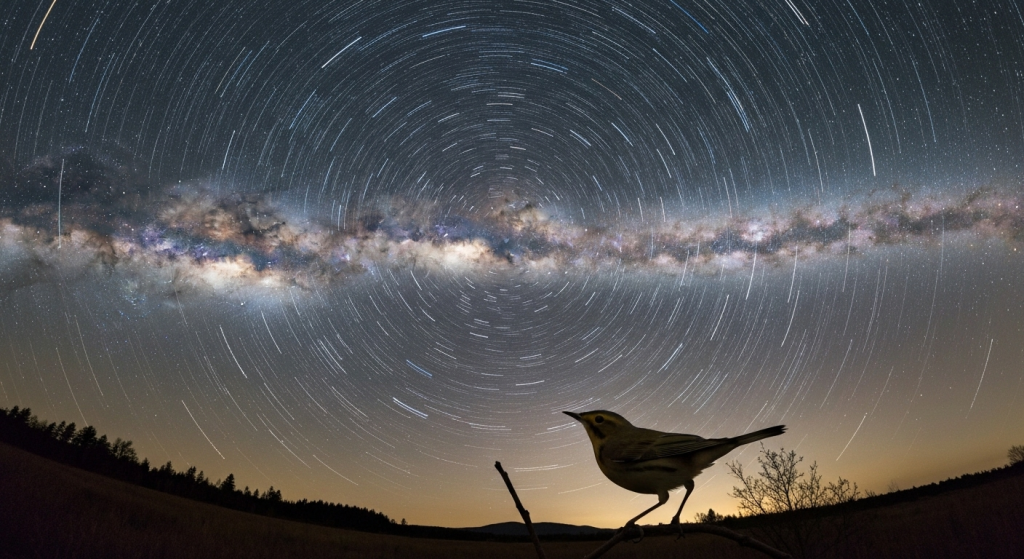
One of the most profound discoveries from the planetarium experiments was that warblers don’t navigate by individual stars. Instead, they learn to identify the center of rotation in the night sky. In the Northern Hemisphere, stars appear to rotate around a single, stationary point—the North Celestial Pole. Polaris just happens to be very close to this point, but it’s the rotation itself that matters.
This makes perfect sense from an evolutionary standpoint. Over thousands of years, the exact star marking true north can change due to the Earth’s axial precession (a slow wobble). A bird that relies only on Polaris would be lost if it lived in a different era. But a bird that understands the concept of a stationary point amidst a sea of rotating stars has a timeless navigation system. They identify north by finding the pivot point that the rest of the sky wheels around.
The Critical Learning Period: Imprinting the Star Map
So, how do they learn this? It’s not pure instinct. Warblers go through a critical learning phase when they are young. Before their first migration, juvenile birds spend nights observing the sky. They watch the stars rotate and essentially “imprint” this celestial map into their brains. They learn to recognize the constellations and, most importantly, to identify the part of the sky that doesn’t move.
This was tested in the lab by raising young birds in a planetarium.
- One group was exposed to a correctly rotating sky. They learned to navigate perfectly.
- Another group was exposed to a sky that rotated around a different point (say, around the star Betelgeuse in Orion). When tested later, these birds oriented themselves based on this incorrect center of rotation.
- A third group was raised with no sky view at all. They were completely unable to orient themselves using the stars.
This proves that warblers are born with the ability to learn the star map, but they need actual experience watching the sky to calibrate their internal compass. This learning happens only during a specific window in their early development.
| Navigation Cue | Description | How Warblers Use It |
| Center of Rotation | The stationary point in the night sky (North Celestial Pole). | The primary reference point for establishing “north.” Learned during a critical period after hatching. |
| Constellations | Major star patterns like the Big Dipper and Cassiopeia. | Act as large-scale signposts that help locate the center of rotation quickly. They provide redundant geometric cues. |
| Polaris (North Star) | The star currently located very close to the North Celestial Pole. | A useful, bright indicator of the center of rotation, but not essential. The system works even without it. |
What Happens on a Cloudy Night? The Backup Systems
The star compass is an incredible tool, but it has an obvious weakness: clouds. So what does a warbler do when its primary map is obscured? It doesn’t just give up. Birds have a multi-layered navigation system with built-in redundancies. When the stars are hidden, they switch to their backup tools.
The Quantum Compass: Sensing Magnetic Fields
The most important backup system is magnetoreception, the ability to sense the Earth’s magnetic field. While we experience the world through five senses, many birds have a sixth sense that allows them to perceive magnetic lines of force. They don’t sense it like a pull on a compass needle. Instead, scientists believe they can actually see the magnetic field.
The leading theory, known as the Radical Pair Model, suggests this sense is located in the bird’s eyes.
- A protein in the retina called cryptochrome absorbs a photon of light.
- This creates a pair of molecules with entangled electrons (a “radical pair”).
- The Earth’s magnetic field affects how long these electrons stay entangled.
- This interaction creates a visual pattern that is superimposed on the bird’s normal vision.
Essentially, the bird might see patterns of light or dark that change depending on which way it looks, giving it a visual cue for north and south. From my experience observing migratory patterns, you often see large flights on clear nights after a storm passes. This is likely because the birds waited for the clouds to clear to use their preferred star compass, even though they could have flown using their magnetic sense.
Other Navigational Aids
While stars and magnetic fields are the main tools for night migration, birds have even more senses they can draw on.
- Polarized Light: Just before sunset and after sunrise, the pattern of polarized light in the sky is aligned in a predictable east-west band. Even when the sun itself is not visible, this band can give the bird a final directional calibration before it takes off for the night.
- Infrasound: Some researchers believe birds can hear very low-frequency sounds (infrasound) that travel for thousands of miles. The sound of waves crashing on a distant shore or wind moving over a mountain range could act as a large-scale acoustic landmark.
Here’s a look at the pros and cons of their primary and secondary navigation systems.
| System | Pros | Cons |
| Star Compass | Extremely precise for finding true north. Stable and reliable on a clear night. | Completely useless during overcast or stormy weather. |
| Magnetic Compass | Works in all weather conditions, day or night. Always available. | Provides only a general direction (a magnetic “inclination” compass), not a precise geographic map. Susceptible to magnetic anomalies. |
The Human Impact: Light Pollution and the Future of Migration
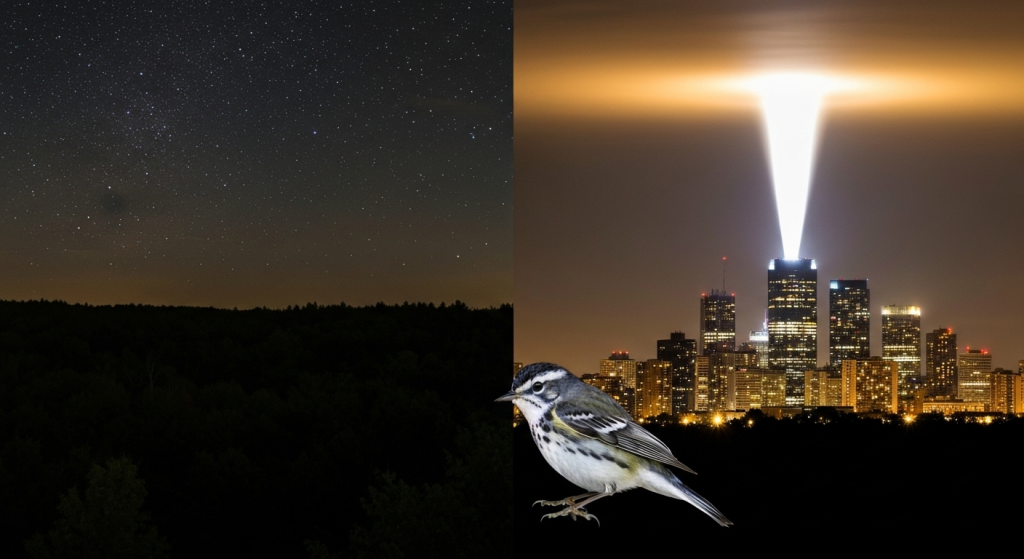
The warbler’s ancient navigation system is now facing a modern threat: light pollution. The artificial glow from cities and towns can wash out the stars, making it difficult for birds to see their celestial map. This is especially problematic for young birds on their first migration who need a clear view to properly calibrate their internal compass. In some brightly lit urban areas, birds can become disoriented, circling buildings for hours until they are exhausted or collide with windows.
As someone who works to understand and protect these creatures, this is a major concern. The simple act of turning off non-essential lights during peak migration months (typically spring and fall) can make a huge difference. Programs like Audubon’s “Lights Out” are raising awareness and helping to create safer skies for these incredible travelers. It’s a reminder that our actions on the ground have a direct impact on the lives playing out high above us in the night sky.
Frequently Asked Questions (FAQs)
1. Do all migrating birds use the stars to navigate?
Not all of them. While many night-migrating songbirds, like warblers, rely heavily on their star compass, birds that migrate during the day (like hawks and eagles) primarily use the sun’s position and landscape features. Waterfowl might use a combination of cues.
2. How do warblers navigate when they cross the equator?
This is a fascinating question. Once a bird crosses into the Southern Hemisphere, its view of the northern stars disappears, and the southern stars rotate in the opposite direction. Research suggests that at this point, they rely almost entirely on their magnetic compass to continue their journey.
3. Can a warbler get permanently lost on a cloudy night?
It’s unlikely. A single cloudy night won’t cause a healthy bird to get permanently lost because its magnetic compass still works. It can continue in the correct general direction. The bird might choose to land and wait for clearer weather, or it will simply continue its journey using its backup sense until the stars become visible again.
4. How accurate is a warbler’s star compass?
It is remarkably accurate. Experiments have shown they can detect their intended migratory direction with a high degree of precision. It’s not just a general sense of “north” or “south”; they are able to find a very specific directional heading.
Conclusion
The journey of a migrating warbler is a testament to the power of evolution. These tiny birds are not just passively drifting on the wind; they are active and skilled navigators. Using a sophisticated star compass imprinted in their youth, they read the geometry of the cosmos to guide them across continents. They carry within them a backup magnetic sense, a quantum compass rooted in the physics of their own eyes, ready to take over when the stars are veiled. The next time you find yourself under a clear, dark sky, take a moment to look up. Remember that you are seeing the very same map that guides millions of tiny travelers on one of the most remarkable journeys in the natural world.
